
|
|
 |

|


|
Yamaha RX-A730 Review
7.2 Channel Network AV Receiver, $699
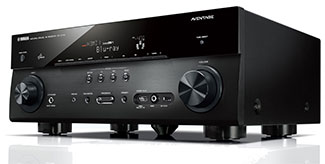
Dick De Jong Introduction
Even though the RX-A730 is the most wallet-friendly (least expensive) of Yamaha's 2013 AVENTAGE series of network AV receivers, it still delivers plenty of aural power along with a generous package of features including Pandora and Rhapsody streaming apps, Internet radio and AirPlay. And with Ultra HD (4K) Pass-through and Upscaling, the stylish RX-A730 could serve as the control center for your small to medium-sized home theater for next five or six years. The AV receiver even provides an independent Zone 2 component that can feed a separate pair of speakers in another room with its own content. Of note, if you are looking for a receiver with Bluetooth or WiFi built-in, the RX-A730 supplies neither. Yamaha offers the YWA-10 Wi-Fi adapter and the YBA-11 Bluetooth Wireless Adapter as optional accessories to purchase. (Editor's note: Yamaha presents five models in its 2013 AVENTAGE line with a progression of features and prices. The RX-A830 is most similar to its A730 sibling. Considering the few added features on the A830, this review can apply to both models.) Out of the Box
Granted, many AV receivers never see the light of your home theater because they are tucked away in a behind-the-curtain equipment room. Be that as it may, the Yamaha designers always seem to style their creations for the spotlight. The seductive RX-A730 is no exception, with its black, brushed aluminum façade with a slanted profile. 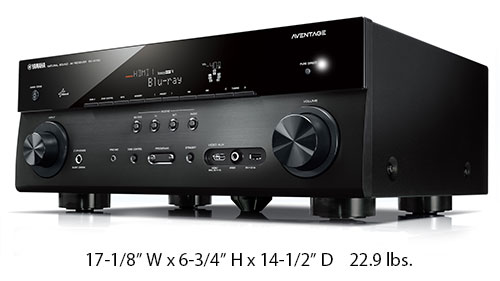 If you sneak a peek under the unit, you will discover a fifth foot, which Yamaha dubs the Anti-Resonance Technology (A.R.T.) Wedge that dampens vibrations. Let's continue this tour with the crowded back of the RX-A730. As you can see from the enlarged image, Yamaha offers five HDMI inputs and one HDMI out (which is ARC [Auto Return Channel] compatible). In addition, it provides plenty of RCA type AV connections for more legacy equipment, along with both optical and coaxial digital audio inputs and a LAN port to connect to your network. The seven speakers connections (Front, Center, Surround and Surround Back) are compatible with banana plugs, as are the Zone 2 outputs (that also can be employed as Front Presence speakers in the main surround sound setup). The RX-A730 can also supply two subwoofers. Around the front are buttons and knobs galore. Most you will never touch simply because you will use your remote control to operate this unit. But it's always comforting to know they are there when inevitably the remote hides in the sofa cushions. Also on the front panel are five connectors: a headphone jack, another HDMI input (MHL compatible for smartphones), a composite video in, a USB port (for flash drives or an iPod/iPad), and an input for the YPAO microphone, which I will discuss later. Looking inside the RX-A730, Yamaha states the "full discrete amp configuration: 105 W per channel (8 ohms, 1 kHz, 0.9% THD, 1 ch driven) and 90 W per channel (8 ohms, 20 Hz-20 kHz, 0.09% THD, 2 ch driven)." And here is a chart of compatible formats that Yamaha provides. 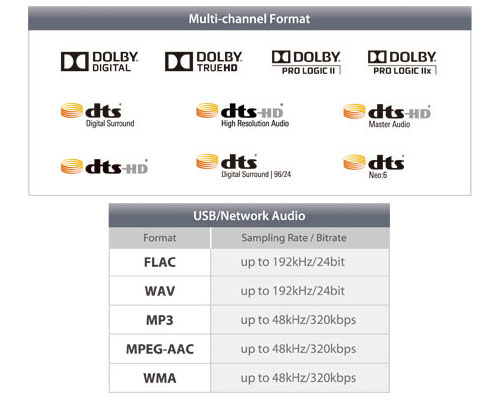 And while I'm at it, I said that this Yamaha receiver is feature-rich and below is yet another chart listing many of them. 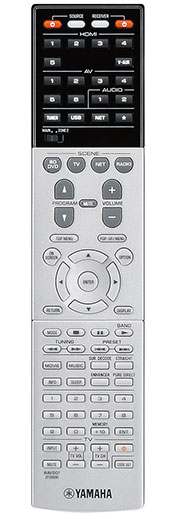
Most of the list is self-explanatory. "Scene" is a handy feature, especially if you are using the RX-A730 to tap an assortment of content sources. There are four preset Scenes, (BD/DVD, TV, Net and Radio), which have their dedicated buttons on the front of the RX-A730 as well as on the remote control. When you choose one such as BD/DVD, the receiver powers On and switches to HDMI 1 input, changes the Sound Program to Movie (Sci-Fi) and turns off the Compressed Music Enhancer. Of course, all four Scenes can be customized to your system's configuration. The long (almost 9" x 2") black and silver remote control is overflowing with small, non-backlit buttons with tiny labels that are hard to see even in a well-lit room. Woe is you, in a darkened home theater. Then again, the RX-A730 is a true multi-unit device, all of which require their own buttons. To facilitate the situation, Yamaha furnishes an AV Controller App (from iTunes App Store, Google Play, or Amazon app store), which you can download onto your compatible smartphone or tablet. Especially on a tablet, the interface is much easier to see and operate. Setup
I won't sugarcoat this, setting up the Yamaha RX-A730 - or any modern AV receiver - is not an stress-free undertaking. Considering all the connections and devices involved, "Clear eyes, full hearts" are required. The manual does a good job of guiding through the basics. But when setting up items like the ARC (Audio Return Channel) feature, the process can become a bit byzantine with the directions hopping you around to multiple pages. Once you have your speakers connected and placed in your room, you definitely should run the YPAO (Yamaha Parametric room Acoustic Optimizer) R.S.C. (Reflected Sound Control) Sound Optimization, which is a $10 term for calibrating your speakers. Conveniently, it is an automated process in which you plug in the supplied YPAO microphone and place it where your ears would normally be in your viewing room.  YPAO Microphone The system sends out tones from your speakers and then "calibrates audio parameters to achieve optimum sound." The procedure is quick, easy and effective, definitely worth doing. My best advice for setting up the RX-A730, plan on allocating quiet alone time with the unit and the 131 page manual. You might be surprised about what little nuggets you can discover in there. Performance
The simplest way that I can describe the performance of the Yamaha RX-A730 is that it increased my appreciation of my speaker system. The sound was clean and the separation clear. The DTS HD Master Audio soundtracks on Blu-rays like Oblivion reverberate impressively around the room. If you want to play sound engineer, you can sample the Sound Programs like Hall in Munich, Cellar Club and Bottom Line. To tweak even further, if you have trouble discerning the dialogue in a program, you can adjust the Dialogue Level and even fine tune Dialogue Lift, which "raises the sound of dialogue from the center speaker to a position in the center of the screen." The RX-A730's power provides plenty of pure sounding oomph to wake the next door neighbors out of a deep sleep. Of course, a sound system is only as good as its weakest link and if you have scrawny speakers expect puny audio quality. And finally, a first impression on the RX-A730's Ultra HD upscaling ability, since I am reviewing the Sony XBR-65X900A 4K TV, I was able to perform an informal visual evaluation of the Yamaha's capability to upscale 1080p content to 2160p (Ultra HD). You have to dig into the RX-A730's menu to activate this feature and once you do, there are no fine tuning controls and I didn't expect any. My test content was the Bubbleship vs. the Droids battle on the 1080p Blu-ray of Oblivion. I chose it because it contained a lot of quick action scenes.  As a reference, I watched the scene as the RX-A730 simply passed through the 1080p signal to the Sony Ultra HD TV, which then upconverted it to 2160p. After that, I switched the AV receiver to Processing Video mode and chose 4K as the resolution. To me, the resulting image looked a little sharper than what the Sony TV produced, but that is not necessarily desirable. The image tended to be a little edgy. Though others might prefer that look. The real difference was in shots with a lot of motion or camera movement. The RX-A730's upscaling didn't seem as smooth as the Sony TV's processing. It's as if the Yamaha's scaler couldn't always keep up with interpolating the stream of data. My feeling is that with all of the more expensive new Ultra HD TVs being released, their Ultra HD scalers will outperform the RX-A730's. Therefore, you may only need to recruit the more than adequate RX-A730 Ultra HD scaler if you purchase a budget Ultra HD TV. Value
The AV receiver market is crowded with highly respectable, feature laden models making for some stiff competition. The Yamaha RX-A730's $699 tag puts it squarely in the midst of the fray with comparable units. The price is fair for all of the bells and whistles in the package. As I write this, I'm finding it online for $650, which is tempting, but I wouldn't call it a bargain. Now, if it dropped below $600. And when you are comparing the RX-A730 to other models, remember that it builds in neither Bluetooth nor a wireless adapter. Conclusion
The Yamaha RX-A730 7.2 channel network AV receiver (with independent Zone 2) delivers clean sound with enough power to effortlessly fill a medium-sized room. With a variety of connectivity options like AirPlay and future-proof features like Ultra HD (4K) Pass-through and Upscaling, the RX-A730 could serve as the control center for your home theater for years to come. |
Bookmark:
![]() del.icio.us
del.icio.us
![]() Reddit
Reddit
![]() Google
Google
Reader Comments
Posted Mar 10, 2014 5:55:23 PM |
|
By Phil |
|
| Send this Page | Print this Page | Report Errors |


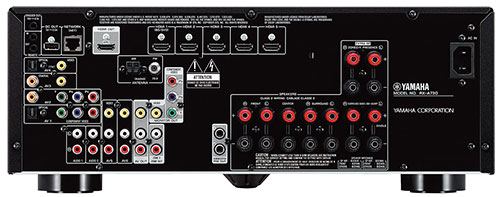
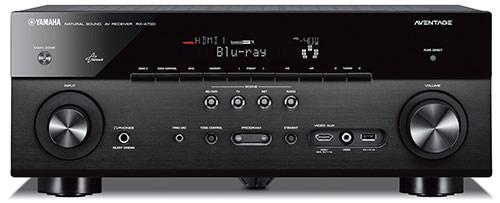


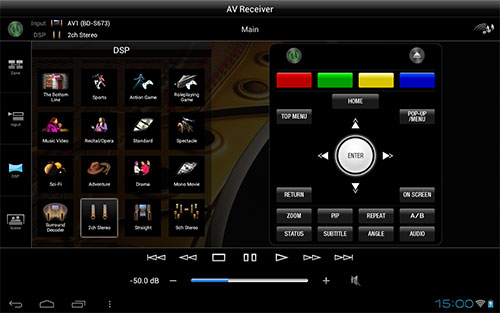

Posted Dec 4, 2015 8:10:01 AM
By Allan Reade